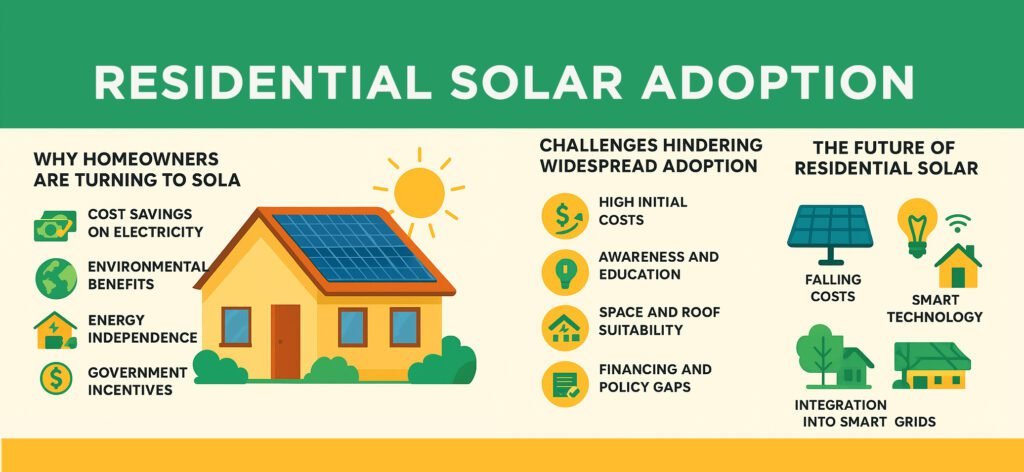In recent years, residential solar adoption has grown from a niche concept into a mainstream energy solution across the world. Rising electricity costs, concerns about climate change, and the quest for energy independence are driving households to embrace solar panels on rooftops as a practical and profitable choice. In countries like India, the United States, Germany, and Australia, millions of homes are now generating their own clean energy, reshaping not just the power sector but also the way people live.
Why Homeowners are Turning to Solar
1. Cost Savings on Electricity
The biggest driver of residential solar adoption is the promise of lower power bills. Once installed, rooftop solar panels can generate electricity for 20–25 years with minimal maintenance. Many households even eliminate their electricity bills altogether, depending on system size and consumption.
In regions with net metering policies, excess electricity generated during the day is fed back into the grid, and homeowners earn credits or payments, further reducing costs.
2. Environmental Benefits
Solar power is a clean, renewable energy source that reduces dependence on coal and gas. By installing panels, a household can offset tons of carbon dioxide emissions annually. For environmentally conscious families, residential solar adoption is a direct way to contribute to the fight against climate change.
3. Energy Independence
With frequent power cuts or rising tariffs in many regions, households value the stability that solar brings. When paired with battery storage systems, solar-equipped homes can function independently of the grid, ensuring uninterrupted power during outages.
4. Government Incentives
Many governments offer subsidies, tax credits, or low-interest loans to promote rooftop solar adoption. For example, India’s Ministry of New and Renewable Energy (MNRE) provides financial support for residential solar installations, while the U.S. offers federal tax credits. Such incentives make solar more affordable and accelerate its adoption.
Global Trends in Residential Solar
Residential solar adoption is rising globally, but the pace varies by region:
-
United States: States like California and Texas lead the solar revolution, supported by strong incentives and high electricity costs.
-
Europe: Germany and Spain have embraced rooftop solar due to progressive policies and sustainability goals.
-
Australia: With abundant sunlight, Australia has the world’s highest per capita rooftop solar adoption.
-
India: With government subsidies and increasing awareness, residential solar is becoming common in both cities and smaller towns.
These global trends highlight that with the right mix of policy, economics, and awareness, residential solar adoption can thrive anywhere.
Challenges Hindering Widespread Adoption
Despite its promise, residential solar adoption faces several challenges:
-
High Initial Costs
The upfront investment for solar panels, inverters, and batteries can be significant. Although prices have fallen drastically over the past decade, affordability remains a concern for middle- and lower-income households. -
Awareness and Education
Many homeowners are unaware of the benefits of solar or lack trusted information on installation processes, financing, and payback periods. Misconceptions about performance during cloudy days or maintenance needs also slow adoption. -
Space and Roof Suitability
Not all rooftops are ideal for solar panels. Shaded areas, weak structural integrity, or limited roof space can restrict installations. -
Financing and Policy Gaps
Access to financing is a hurdle in many regions. While banks and solar companies are offering loans and leasing models, greater institutional support is required. Inconsistent government policies and regulatory hurdles in net metering also discourage adoption.
The Role of Technology
Technological innovation is making solar more attractive for homeowners.
-
High-Efficiency Panels: Modern solar panels can generate more electricity in less space, making them suitable for urban homes with limited rooftop area.
-
Smart Inverters: Advanced inverters allow better monitoring and integration with home energy systems.
-
Battery Storage: Falling prices of lithium-ion batteries enable homeowners to store excess energy for nighttime use, enhancing self-reliance.
-
Digital Platforms: Apps and IoT-based systems allow households to track energy generation and consumption in real time, empowering them to maximize savings.
The Future of Residential Solar
The future of residential solar adoption is bright. With falling costs, rising electricity demand, and supportive policies, rooftop solar will likely become a default choice for new homes worldwide. Industry analysts predict that residential solar capacity will grow at double-digit rates annually through the next decade.
Moreover, residential solar will play a crucial role in smart grids and decentralized energy systems. Instead of relying solely on large power plants, future electricity networks will depend on millions of homes producing, storing, and sharing power—a concept often referred to as “prosumers” (producers + consumers).

